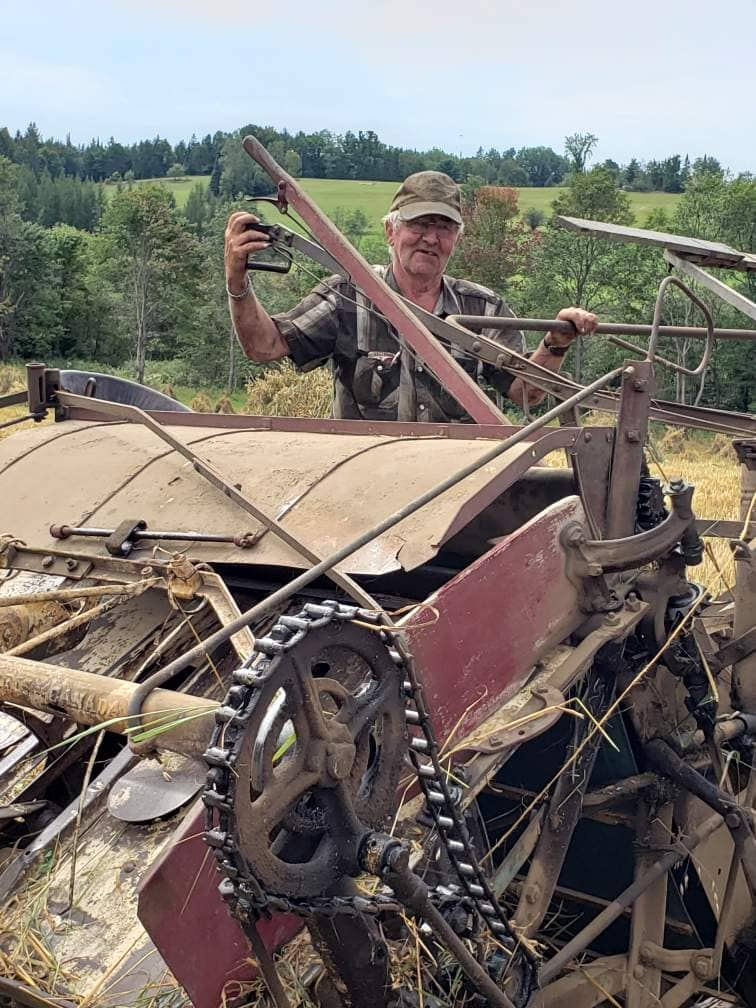|
Bancroft this Week https://www.bancroftthisweek.com/a-good-old-fashioned-oat-threshing/ Export date: Tue Apr 1 23:44:34 2025 / +0000 GMT |
A good old fashioned oat threshing By Kristena Schutt-Moore A piece of this area's farming past came back to life during the first weeks of September as area farmers brought history back to life in Hastings Highlands. This growing season saw six weeks of very dry weather and then a month of rain. This caused the oats in the fields to grow at a variety of heights and maturity. Some of the oats were ripe and some were still green come time to harvest them. The state of the oats wasn't good for the combine tractor that is typically used to harvest the fields, so it was back to the binder and thrasher for the Robinson boys. After they were cut with a seven foot cut 1950 Massey Harris binder the Robinsons and their neighbours manually put the sheaves into stooks and left in the fields to ripen and dry for about seven days. Stooks are the bundles that were often found tied and left standing in fields before bails were made possible and popular by newer tractors. The stooks were then loaded onto wagons and taken to the bard to be threshed and put into the barn. The threshing machine is a 1957 McCormick which the Robinsons have been taking care of and using since it came to the farm. The tractor that ran it this year belonged to the Robinson's farming neighbour Lynn Davis. It was a 1944 Massey Harris that took him 10 years to refurbish and restore. He used to show it at area fairs and it won several awards at several shows. The tractor is belt driven unlike modern tractors, so it can be used to belt drive the thresher by attaching the machine with a larger belt. Hald Robinson says it is much more work, to thresh oats, but he enjoys doing it the old time way as you get much cleaner oats. The stooks on the wagon are loaded into the thresher with pitchforks one by one. Once placed on the convener belt the thresher grabs each stook by the seed tops first. The mechanical teeth then remove the seeds and thresh the plants and separate the seeds from their plant stocks. The heavier seeds fall to the bottom of the thresher and are blown through a tube into the barn store room. The lighter stocks are blown out through a separate tube and piled to the side. These stocks and pieces are then bailed into square bales to be used as animal bedding this winter. Not one piece of the oat plant is wasted this way. “Family, friends and neighbours helped stook the grain and load it on the wagons to prepare for threshing. It's great to see people who are still willing to help with threshing as it's not an easy job. This is how the people years ago used to go from farm to farm for the fall harvest helping each other. People came just to watch and were saying that they enjoyed just watching this take place as you don't see this very often anymore.” explained Wilma Robinson. |
|
Post date: 2021-09-14 17:16:08 Post date GMT: 2021-09-14 21:16:08 Post modified date: 2021-09-14 17:16:17 Post modified date GMT: 2021-09-14 21:16:17 |
|
Export date: Tue Apr 1 23:44:34 2025 / +0000 GMT This page was exported from Bancroft this Week [ https://www.bancroftthisweek.com ] Export of Post and Page has been powered by [ Universal Post Manager ] plugin from www.ProfProjects.com |